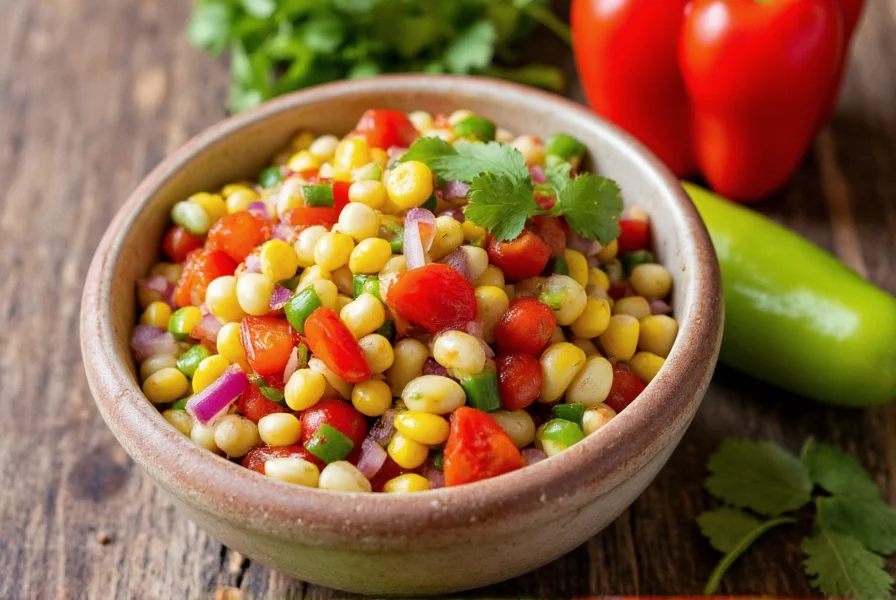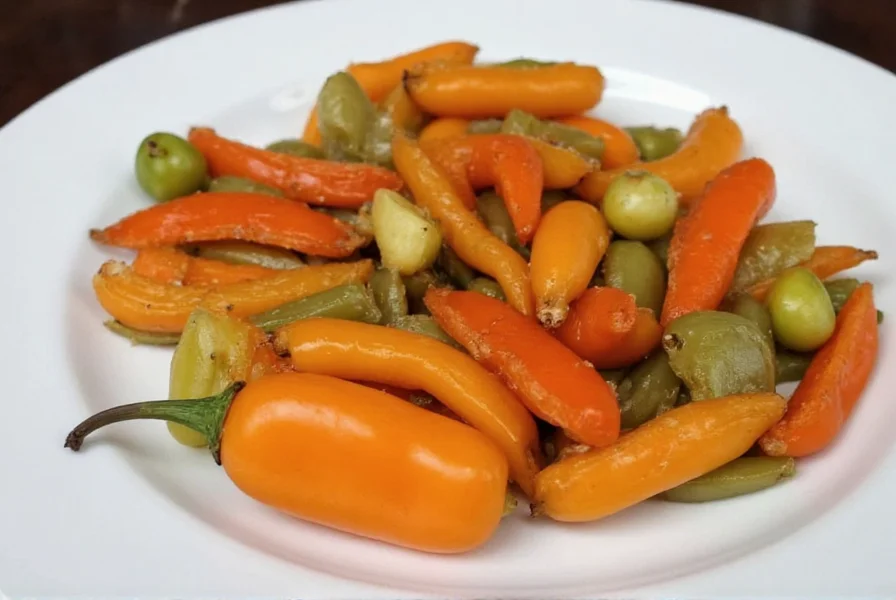Banana peppers, with their cheerful yellow color and mild heat profile, are culinary gems that deserve more attention in home cooking. These slender peppers, scientifically known as Capsicum annuum, start green and mature to vibrant yellow, then sometimes to red. Unlike their spicier pepper relatives, banana peppers deliver just enough heat to add dimension without overwhelming other flavors—typically ranging from 0-500 Scoville units, compared to jalapeños' 2,500-8,000 units.
What makes banana peppers particularly valuable in the kitchen is their versatility. They can be eaten raw in salads, stuffed with fillings, roasted for depth of flavor, or pickled for tangy preservation. Their thin walls make them quicker to cook than bell peppers, while their slightly curved shape (resembling a banana, hence the name) creates perfect little vessels for stuffing. When selecting banana peppers, look for firm, glossy specimens without wrinkles or soft spots—these indicate freshness and optimal texture for cooking.
Understanding Banana Pepper Flavor Profiles
Banana peppers actually encompass several varieties with subtle flavor differences:
| Pepper Type | Heat Level (Scoville) | Flavor Characteristics | Best Culinary Uses |
|---|---|---|---|
| Yellow Banana | 0-500 | Mildly sweet with subtle tang | Salads, sandwiches, pickling |
| Hot Banana | 500-1,000 | Noticeable heat with citrus notes | Salsas, stir-fries, stuffed dishes |
| Red Banana | 0-500 | Sweeter, more mature flavor | Roasting, sauces, garnishes |
Understanding these variations helps you select the right banana pepper for specific recipes. For family-friendly dishes where minimal heat is preferred, yellow banana peppers work perfectly. When you want a bit more kick without overwhelming spice, hot banana peppers deliver. Red varieties, being fully mature, offer the sweetest flavor profile ideal for sauces and roasted applications.
Essential Preparation Techniques
Before diving into recipes, proper preparation ensures the best results with banana peppers:
- Washing: Rinse under cool water and pat dry thoroughly—moisture affects roasting and stuffing
- Seeding: For milder flavor, remove seeds and white membranes (where most capsaicin resides)
- Slicing: Use a sharp knife on a stable cutting board—thin slices for salads, thicker for stuffing
- Storage: Keep unwashed in crisper drawer for up to 2 weeks, or freeze roasted peppers for 6 months
Top 5 Banana Pepper Recipes for Every Occasion
1. Classic Stuffed Banana Peppers with Quinoa and Feta
This vegetarian-friendly dish showcases banana peppers as edible containers. The mild heat complements the Mediterranean flavors without overpowering them.
Ingredients:
- 8 medium yellow banana peppers, tops cut off and seeded
- 1 cup cooked quinoa
- ½ cup crumbled feta cheese
- ¼ cup diced tomatoes
- 2 tbsp chopped fresh parsley
- 1 tbsp olive oil
- Salt and pepper to taste
Instructions:
- Preheat oven to 375°F (190°C)
- Mix quinoa, feta, tomatoes, parsley, olive oil, salt and pepper in a bowl
- Stuff mixture into prepared banana peppers
- Place upright in baking dish, cover with foil
- Bake for 25 minutes, then uncover and bake 10 more minutes
- Serve warm as a main dish or side
This recipe for stuffed banana peppers with quinoa and feta makes an excellent meatless Monday option that even pepper-averse family members will enjoy. The banana peppers soften beautifully while retaining their shape, creating a visually appealing dish that's perfect for dinner parties or meal prep.
2. Quick-Pickled Banana Peppers
These tangy pickled banana peppers add instant flavor to sandwiches, salads, and charcuterie boards. Unlike store-bought versions, homemade pickled banana peppers maintain better texture and allow you to control the spice level.
Ingredients:
- 10 fresh banana peppers, sliced into rings
- 1 cup white vinegar
- 1 cup water
- 2 tbsp sugar
- 1 tbsp pickling salt
- 2 garlic cloves, smashed
- 1 tsp mustard seeds
Instructions:
- Combine vinegar, water, sugar, and salt in a saucepan; bring to boil
- Place pepper slices, garlic, and mustard seeds in clean mason jar
- Pour hot liquid over ingredients, leaving ½ inch headspace
- Cool to room temperature, then refrigerate
- Ready to eat in 24 hours; best flavor after 1 week
These quick-pickled banana peppers maintain their vibrant color and develop complex flavor over time. They're ideal for adding to Greek salads, topping burgers, or serving alongside grilled meats. For a spicier version, leave some seeds in the pepper slices before pickling.
3. Banana Pepper and Corn Salsa
This refreshing salsa combines the mild heat of banana peppers with sweet corn for a versatile condiment that works equally well with chips, on grilled fish, or as a taco topping.

Ingredients:
- 2 large banana peppers, finely diced
- 1 cup fresh corn kernels (or thawed frozen corn)
- ½ red onion, finely diced
- 1 large tomato, seeded and diced
- ¼ cup fresh cilantro, chopped
- 2 tbsp lime juice
- 1 tbsp olive oil
- Salt to taste
Instructions:
- Combine all ingredients in a medium bowl
- Gently mix until evenly distributed
- Cover and refrigerate for at least 1 hour before serving
- Stir before serving and adjust seasoning if needed
This banana pepper and corn salsa recipe creates a balanced flavor profile where the mild heat of the peppers complements rather than dominates. The corn adds natural sweetness that pairs perfectly with the tangy notes of banana peppers. For best results, use fresh corn when in season, but frozen corn works well year-round after a quick blanch.
4. Roasted Banana Pepper Pasta Sauce
This simple yet sophisticated sauce transforms banana peppers into a creamy, flavorful pasta topping that's ready in under 30 minutes.
Ingredients:
- 6 banana peppers, halved lengthwise
- 3 garlic cloves, unpeeled
- 2 tbsp olive oil
- ½ cup vegetable broth
- ¼ cup heavy cream or coconut milk
- Salt and black pepper to taste
- 1 lb cooked pasta of choice
- Fresh basil for garnish
Instructions:
- Toss pepper halves and garlic with olive oil; roast at 400°F (200°C) for 20 minutes
- Squeeze roasted garlic from skins into blender
- Add roasted peppers, vegetable broth, and cream; blend until smooth
- Season with salt and pepper
- Toss with cooked pasta and serve with fresh basil
This roasted banana pepper pasta sauce demonstrates how cooking transforms the pepper's flavor profile. Roasting brings out natural sweetness while mellowing any heat, creating a complex sauce that's neither too spicy nor bland. The garlic adds depth without overpowering, making this an excellent option for those who typically avoid spicy foods but want interesting flavor.
5. Banana Pepper Pizza Topping
Move beyond standard pizza toppings with this simple yet flavorful banana pepper variation that works with any pizza style.
Ingredients:
- 4-5 banana peppers, thinly sliced
- 1 tbsp olive oil
- 1 tsp dried oregano
- ½ tsp garlic powder
- Salt to taste
- Your favorite pizza dough and sauce
- 2 cups shredded mozzarella
Instructions:
- Toss sliced peppers with olive oil, oregano, garlic powder, and salt
- Spread pizza sauce on dough, add cheese, then arrange pepper slices on top
- Bake according to dough instructions until cheese is bubbly
- Let rest 5 minutes before slicing
This banana pepper pizza topping recipe showcases how these peppers can enhance familiar dishes with minimal effort. The mild heat complements traditional pizza flavors without overwhelming them, making it family-friendly while still offering something different. For extra flavor dimension, try combining banana peppers with black olives and red onions.
Advanced Cooking Tips for Perfect Banana Pepper Dishes
Take your banana pepper recipes to the next level with these professional techniques:
- Blanching for milder flavor: Briefly dip peppers in boiling water for 30 seconds, then ice water to reduce heat while maintaining crispness
- Flavor layering: Combine banana peppers with complementary ingredients like lemon zest, fresh herbs, or smoked paprika to enhance their natural profile
- Texture preservation: Add banana peppers late in cooking processes to maintain their distinctive crunch in stir-fries and salads
- Heat control: For family meals, remove seeds and white membranes from half the peppers to create a spectrum of heat levels on one dish
Substitution Guide for Banana Pepper Recipes
Can't find banana peppers? These substitutions work in most recipes:
- For mild heat: Yellow bell peppers with a pinch of cayenne (use 1:1 ratio)
- For similar shape: Cubanelle peppers (slightly sweeter, use 1:1 ratio)
- For pickling: Pepperoncini (more tangy, use 1:1 ratio but reduce added vinegar)
- For stuffed dishes: Poblano peppers (more heat, use 1:1 ratio but expect different flavor profile)
Storing and Preserving Your Banana Pepper Harvest
Maximize your banana pepper investment with these storage techniques:
- Fresh storage: Keep unwashed in crisper drawer for up to 2 weeks
- Freezing: Roast or blanch first, then freeze in airtight containers for up to 6 months
- Preserving: Pickling extends shelf life to 1 year in refrigerator
- Drying: Slice thin and dehydrate for 8-12 hours; store in airtight container with silica packet
Frequently Asked Questions
Are banana peppers and pepperoncini the same thing?
No, banana peppers and pepperoncini are different varieties. Banana peppers are typically longer, milder (0-500 Scoville units), and slightly sweeter. Pepperoncini are shorter, have more tangy flavor, and range from 100-500 Scoville units. While they can sometimes substitute for each other, their flavor profiles differ noticeably in dishes like salads and sandwiches.
How can I reduce the heat in banana pepper recipes?
To reduce heat in banana pepper recipes, remove all seeds and white membranes (where most capsaicin resides), blanch peppers in boiling water for 30 seconds followed by ice water, or combine with dairy products like yogurt or cheese which neutralize capsaicin. For stuffed pepper recipes, using yellow rather than red banana peppers provides milder heat as they're less mature.
What's the best way to freeze banana peppers for future recipes?
The best way to freeze banana peppers is to roast or blanch them first. For roasting: slice peppers, toss with olive oil, and roast at 400°F for 20 minutes until slightly charred. For blanching: dip whole peppers in boiling water for 3 minutes, then ice water. Pat dry thoroughly, arrange in single layer on baking sheet, freeze until solid, then transfer to airtight freezer bags. Properly frozen banana peppers maintain quality for 6-8 months.
Can I use pickled banana peppers in recipes that call for fresh?
Yes, but with adjustments. Pickled banana peppers have higher acidity and salt content, so reduce added vinegar and salt in your recipe. Rinse pickled peppers under cold water to remove excess brine before using. They work particularly well in salads, sandwiches, and pasta dishes where their tangy flavor enhances other ingredients. For stuffed pepper recipes, fresh peppers are preferable as they maintain better texture during cooking.
What dishes pair best with banana peppers' mild heat profile?
Banana peppers' mild heat profile complements Mediterranean and Southern European cuisines particularly well. They shine in Greek salads, Italian pasta dishes, Spanish tortillas, and Hungarian stuffed pepper recipes. Their subtle heat also pairs beautifully with creamy ingredients like feta, goat cheese, and avocado, which balance their mild spiciness. For meal prep, banana peppers maintain their texture and flavor better than hotter peppers when incorporated into weekly meal containers.











 浙公网安备
33010002000092号
浙公网安备
33010002000092号 浙B2-20120091-4
浙B2-20120091-4